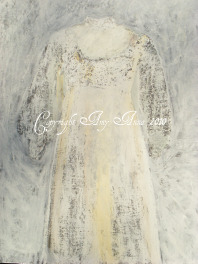
Some articles of clothing have a power far beyond how often they are worn. In fact, it seems that the fewer times one wears something, the greater its influence. The wedding dress is the most obvious example – there are entire TV series devoted to the subject of finding the perfect gown.
I imagine that this is so because some garments embody our deepest wishes and dreams: if the dress is just right, then the marriage will be, too. It is a form of magical thinking. Thus explaining it, does not, however, lessen how powerful the pull of the perfect garment can be.
There’s more to it than that, though. I think certain kinds of dresses represent deep archetypes, and while we can discuss what these dresses mean all the day long, there are profound subterranean psychological attractions going on about clothing that can never be dissected.
I recently started painting dresses. I didn’t realize that I was painting what is known in the art world as “still life”; I thought I was creating figure paintings, just without the people in them. After all, to my mind, I wasn’t painting the dresses as dresses, I was painting the states of mind they represented. My subject wasn’t the dress itself; it was the way it feels to wear certain kinds of clothes. (I discovered this is impossible, or at least, I am not skilled enough to do it. So then I thought, well, I’ll just paint The History of Femininity through Dresses. As if that would be easier. I have settled for the understanding that sometimes as an artist, one has no idea what one is doing, one just has to do whatever it is one is doing as best as possible, get on with the painting, and leave the philosophizing for some very empty day in the far distant future. Yet here I am, still philosophizing.)

When I painted “Little Black Dress,” the first of this series, I realized that by leaving out the model and just painting the dress, I had made it Everyone’s Dress. I can’t necessarily see myself wearing the same dress as some beautiful model, but I can substitute myself for an invisible woman. And then I can imagine what it feels like to wear that beautiful dress. Perhaps I can do this even if I never actually wear that beautiful dress.
How many people’s lives are glamorous?

There is something heartbreaking about prom dresses. Maybe it is more of that magical thinking; when I put this on, I will no longer have to worry about my skin and my hair will look like I meant it to do that and I won’t feel so stupid all the time. That’s the looking forward part. There’s a looking back part, too, depending on the phase of your life span. The looking back part says Jesus I was just so terribly young. That’s why so many artists (I am not blazing the trail here) are painting frilly, poufy 1950’s prom dresses. Those dresses embody that youngness so much more obviously than the prom dresses we actually wore. Those fluffy frills speak so clearly about how youth lifts off in the slightest of breezes and blows away.
Forever.
Loss and yearning. One dress can paint one thousand emotions. One dress can encompass so many dreams.
Young girls want to be sexy. Old girls want to be young.
 RSS Feed
RSS Feed
